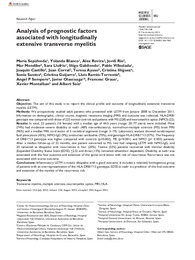Título :
Analysis of prognostic factors associated with longitudinally extensive transverse myelitis |
Autor :
Sepúlveda, María
Blanco, Yolanda
Saiz, Albert 
Gabilondo, Iñigo 
Villoslada, Ana 
Perez-Sempere, Angel 
Ramió-Torrentà, Lluís 
Olascoaga, Javier 
Montalban, Xavier 
Rovira, Alex
Rio, Jordi 
Mendibe , Mar 
Llufriu, Sara
Castilló, Joaquín 
Corral, Juan 
Ayuso, Teresa 
Cristina, Iñiguez 
Santos, Sonia
Guijarro, Cristina 
Graus, Francesc  |
Editor :
SAGE Publications |
Departamento:
Departamentos de la UMH::Medicina Clínica |
Fecha de publicación:
2012-10 |
URI :
https://hdl.handle.net/11000/30615 |
Resumen :
Abstract
Objective: The aim of this study is to report the clinical profile and outcome of longitudinally extensive transverse myelitis (LETM).
Methods: We prospectively studied adult patients who presented with LETM from January 2008 to December 2011. Information on demographic, clinical course, magnetic resonance imaging (MRI) and outcome was collected. HLA-DRB1 genotype was compared with those of 225 normal controls and patients with MS (228) and neuromyelitis optica (NMO) (22).
Results: In total, 23 patients (16 female) with a median age of 44.5 years (range: 20–77 years) were included. Most (74%) had moderate–severe disability at nadir (48% non-ambulatory), normal/non-multiple sclerosis (MS) brain MRI (96%) and a median MRI cord lesion of 5 vertebral segments (range: 3–19). Laboratory analysis showed cerebrospinal fluid pleocytosis (45%), NMO-IgG (9%), antinuclear antibodies (70%), and genotype HLA-DRB1*13 (57%). The frequency of DRB1*13 genotype was higher compared with controls (p=0.002), MS (p=0.001) and NMO (p= 0.003) patients. After a median follow-up of 32 months, one patient converted to MS, two had relapsing LETM with NMO-IgG, and 20 remained as idiopathic with recurrences in four (20%). Twelve (52%) patients recovered with minimal disability (Expanded Disability Status Scale (EDSS) <2.5) and three (13%) remained wheelchair dependent. Disability at nadir was associated with the final outcome and extension of the spinal cord lesion with risk of recurrence. Recurrence was not associated with worse outcome.
Conclusions: Inflammatory LETM is mostly idiopathic with a good outcome. It includes a relatively homogenous group of patients with an overrepresentation of the HLA-DRB1*13 genotype. EDSS at nadir is a predictor of the final outcome and extension of the myelitis of the recurrence risk.
|
Palabras clave/Materias:
Transverse myelitis
multiple sclerosis
neuromyelitis optica
MRI
HLA |
Área de conocimiento :
CDU: Ciencias aplicadas: Medicina |
Tipo documento :
application/pdf |
Derechos de acceso:
info:eu-repo/semantics/openAccess
Attribution-NonCommercial-NoDerivatives 4.0 Internacional |
DOI :
https://doi.org/10.1177/1352458512461968 |
Aparece en las colecciones:
Artículos Medicina Clínica
|
 La licencia se describe como: Atribución-NonComercial-NoDerivada 4.0 Internacional.
La licencia se describe como: Atribución-NonComercial-NoDerivada 4.0 Internacional.
.png)
